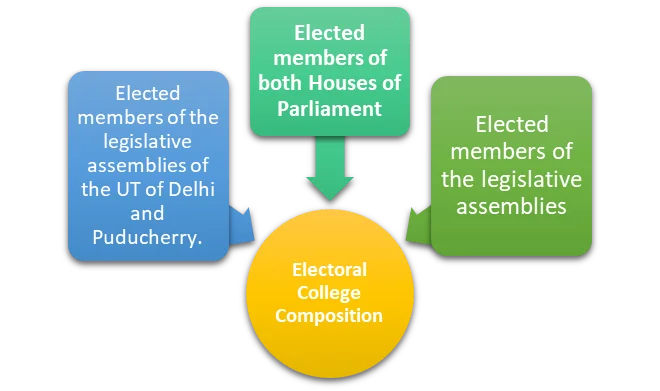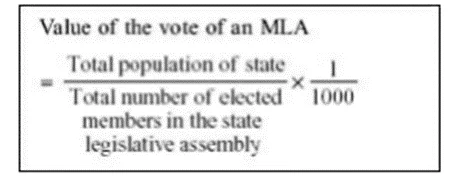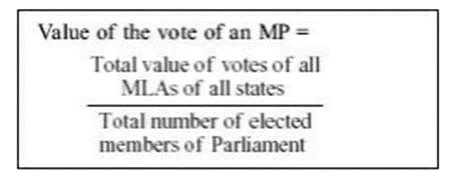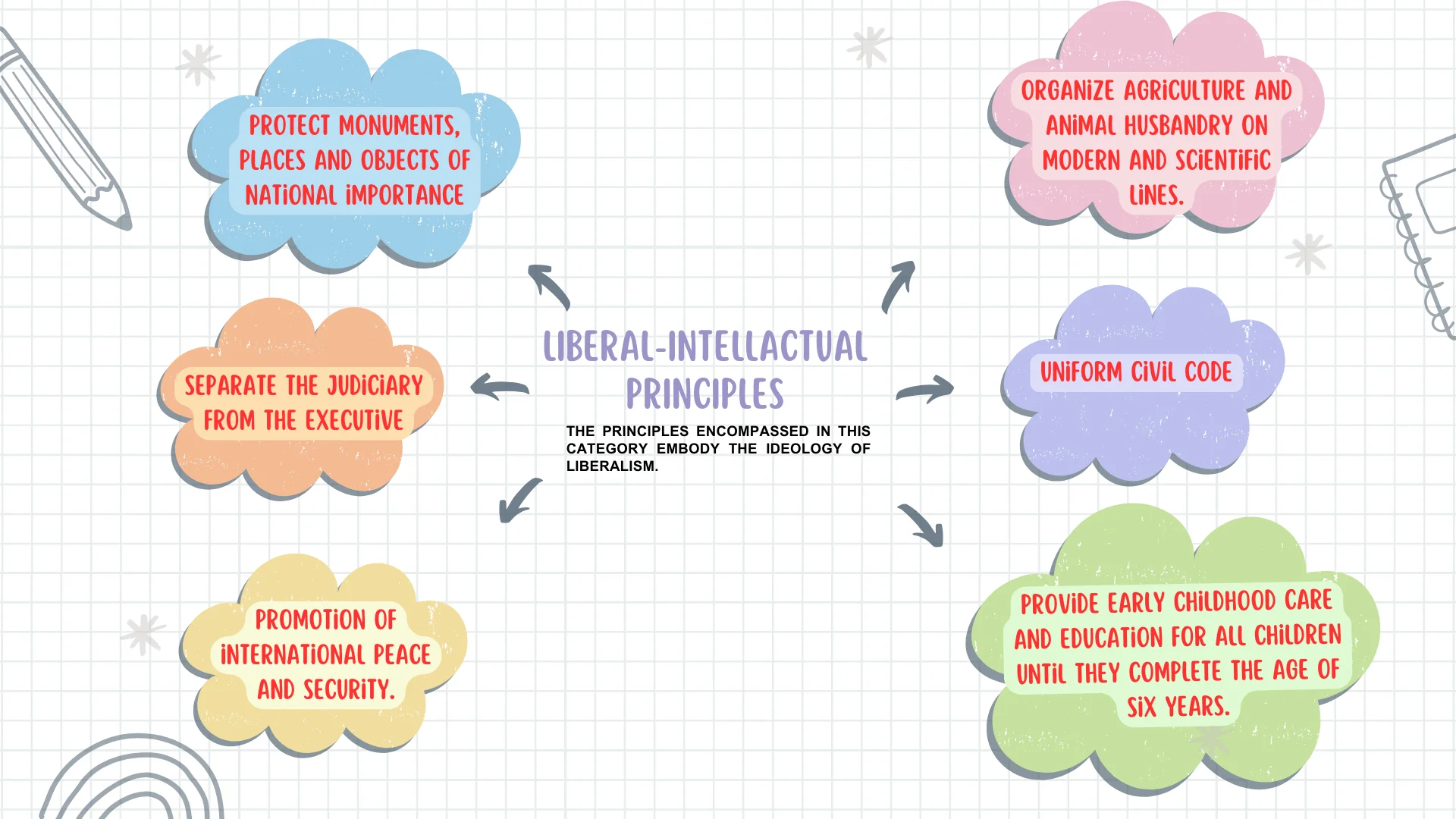The election of the President of India is a vital constitutional process governed by the Presidential and Vice-Presidential Election Act of 1952. This election is conducted by an Electoral College, ensuring representation from both Parliament and state assemblies. The system employs proportional representation with a single transferable vote to maintain fairness. Understanding this process highlights the importance of a President as a unifying figure in the nation.
Election of the President of India
The Constitutional provision for the election of the President was established through the Presidential and Vice-Presidential Election Act of 1952.
- The election procedure has been taken from the Irish Constitution.
Article 54 – Electoral College Composition

- The President of India is elected through an electoral college comprised of the following members:
- Elected members of both the Houses of Parliament.
- Elected members of the legislative assemblies of the states.
- Elected members of the legislative assemblies of the Union Territories of Delhi and Puducherry.
- Exclusions from the Electoral College:
- Nominated members of both Houses of Parliament, nominated members of State Legislative Assemblies, members (both elected and nominated) of State legislative councils (in the case of bicameral legislatures), and nominated members of the Legislative Assemblies of Delhi and Puducherry are not involved in the President’s election.
Enroll now for UPSC Online Course
| REASONING FOR INCLUSION OF MLAs AND EXCLUSION OF MLCs | |
| Inclusion of MLAs | Exclusion of MLCs |
|
|
- Impact of Assembly Dissolution: In instances where a legislative assembly is dissolved, its members no longer qualify to vote in the presidential election, even if fresh elections for the dissolved assembly have not been conducted before the Presidential election.
Article 55 – Manner of Election
- Proportional Representation System: The President of India is indirectly elected by an Electoral College using a system of proportional representation with a single transferable vote and secret ballots.
- Voting by MPs and MLAs: Elected Members of Parliament (MPs) and Legislative Assemblies (MLAs) cast their votes based on parity and uniformity values.
Single Vote System
- Single Vote System: During the Presidential election, each voter can cast only one vote.
- Variable Vote Value for MLAs: While the value of votes by MLAs may vary from state to state (due to variations in a number of legislative assembly seats and the population of the state), the votes by MPs remain constant.
- Example: An MLA from UP has a value of 208, while an MLA from Sikkim has value of 7.
- The population of the state, as per the 1971 census, is taken for the calculation.
- Example: An MLA from UP has a value of 208, while an MLA from Sikkim has value of 7.
- 84th Constitutional Amendment Act of 2001, population is ascertained as that in the 1971 census until the first census after 2026 has been published.
- Uniformity and Parity: The Constitution provides that there shall be uniformity in the scale of representation of different states as well as parity between the states as a whole and the Union at the election of the President.
Value Of The Vote Of An MLA

Value Of The Vote An MP

The total value of MPs’ votes must equal the total value of MLAs’ votes to maintain the State and Union balance.
Quotas
- The candidate who reaches the winning quota or exceeds it is declared the winner.
- Electoral Quota as mentioned below:

-
- For the 2022 Presidential Election, the value of the vote of a Member of Parliament (MP) has gone down to 700 from 708 in the Presidential poll due to the absence of a legislative assembly in Jammu and Kashmir.
| State MLAs Vote Value for Presidential Elections 2022 | ||||
| Name of State | Number of Assembly seats | Population (1971 Census) | Value of vote of each MLA | Total value of votes for the state (B x D) |
| A | B | C | D | E |
| Andhra Pradesh | 175 | 2,78,00,586 | 159 | 27,825 |
| Arunachal Pradesh | 60 | 4,67,511 | 8 | 480 |
| Assam | 126 | 1,46,25,152 | 116 | 14,616 |
| Bihar | 243 | 4,21,26,236 | 173 | 42,039 |
| Chhattisgarh | 90 | 1,16,37,494 | 129 | 11,610 |
| Goa | 40 | 7,95,120 | 20 | 800 |
| Gujarat | 182 | 2,66,97,475 | 147 | 26,754 |
| Haryana | 90 | 1,00,36,808 | 112 | 10,080 |
| Himachal Pradesh | 68 | 34,60,434 | 51 | 3,468 |
| Jammu and Kashmir | 87 | 63,00,000 | 72 | 6,264 |
| Jharkhand | 81 | 1,42,27,133 | 176 | 14,256 |
| Karnataka | 224 | 2,92,99,014 | 131 | 29,344 |
| Kerala | 140 | 2,13,47,375 | 152 | 21,280 |
| Madhya Pradesh | 230 | 3,00,16,625 | 131 | 30,130 |
| Maharashtra | 288 | 5,04,12,235 | 175 | 50,400 |
| Manipur | 60 | 10,72,753 | 18 | 1,080 |
| Meghalaya | 60 | 10,11,699 | 17 | 1,020 |
| Mizoram | 40 | 3,32,390 | 8 | 320 |
| Nagaland | 60 | 5,16,449 | 9 | 540 |
| Odisha | 147 | 2,19,44,615 | 149 | 21,903 |
| Punjab | 117 | 1,35,51,060 | 116 | 13,572 |
| Rajasthan | 200 | 2,57,65,806 | 129 | 25,800 |
| Sikkim | 32 | 2,09,843 | 7 | 224 |
| Tamil Nadu | 234 | 4,11,99,168 | 176 | 41,184 |
| Telangana | 119 | 1,57,02,122 | 132 | 15,708 |
| Tripura | 60 | 15,56,342 | 26 | 1,560 |
| Uttarakhand | 70 | 44,91,239 | 64 | 4,480 |
| Uttar Pradesh | 403 | 8,38,49,905 | 208 | 83,824 |
| West Bengal | 294 | 4,43,12,011 | 151 | 44,394 |
| NCT of Delhi | 70 | 40,65,698 | 58 | 4,060 |
| Puducherry | 30 | 4,71,707 | 16 | 480 |
| Total | 4,120 | 54,93,02,005 | 5,49,495 | |
Voters’ Preference
- Ballot Paper and Preference Marking: Each voter is given only one ballot paper, and the voter is required to indicate his preferences by marking 1,2,3, etc against the names of candidates.
- Elimination and Vote Transfer: If the first-preference candidate doesn’t reach the winning quota, then the first-preferred candidate with the lowest vote is eliminated, and their votes are transferred to the remaining candidates.
- Securing the Required Quota: The process continues till a candidate secures the required quota.
- Ensuring Absolute Majority: This system ensures that the winning candidate is returned by the absolute majority.
- Exemption from Anti-Defection Law: The Anti-defection law, which disallows MPs from crossing the party line, does not apply to the Presidential election. This means that the MPs and MLAs can keep their ballot secret.
Why Proportional Representation System?
- Proportional Representation and Single Transferable Vote System: The President of India is elected through proportional representation using the single transferable vote system (Article 55(3)).
- Independent Candidates and Minority Parties: This system allows independent candidates and minority parties to have representation.
- Encouragement of Coalition Politics: It encourages coalition politics with diverse voter support.
- Balanced Representation: It ensures elected candidates don’t solely represent the majority’s opinion.
Why Indirect Election?
- Complexity: Directly electing the President would be complex and potentially chaotic.
- Public Understanding: The public may lack a clear understanding of the President’s role or the suitability of candidates.
- Nationwide Campaigns: Direct elections would require candidates to campaign nationwide with political party support, causing instability.
- Logistical Challenges and Costs: The logistical challenges and costs of a direct election would strain government resources.
- Maintaining Dignity and Neutrality: Indirect elections maintain the dignity and neutrality of the President’s role and minimise hostilities between states.
Dispute Resolution in Presidential Elections
- Article 71: Implies that all doubts and disputes related to election of President and Vice President shall be inquired and settled by the Supreme Court whose decision is final.
- It also states that no such disputes can be raised on the grounds of any vacancy in the electoral college.

Enroll now for UPSC Online Course
| Must Read | |
| Current Affairs | Editorial Analysis |
| Upsc Notes | Upsc Blogs |
| NCERT Notes | Free Main Answer Writing |
Conclusion
In summary, the election of the President in India reflects a carefully structured system designed to uphold democratic values.
- The indirect election method ensures stability and reduces conflicts while allowing diverse representation. As the head of state, the President symbolizes the integrity of the nation.
- This process emphasizes the significance of balancing power among various political entities in India.
Sign up for the PWOnlyIAS Online Course by Physics Wallah and start your journey to IAS success today!

 GS Foundation
GS Foundation Optional Course
Optional Course Combo Courses
Combo Courses Degree Program
Degree Program











